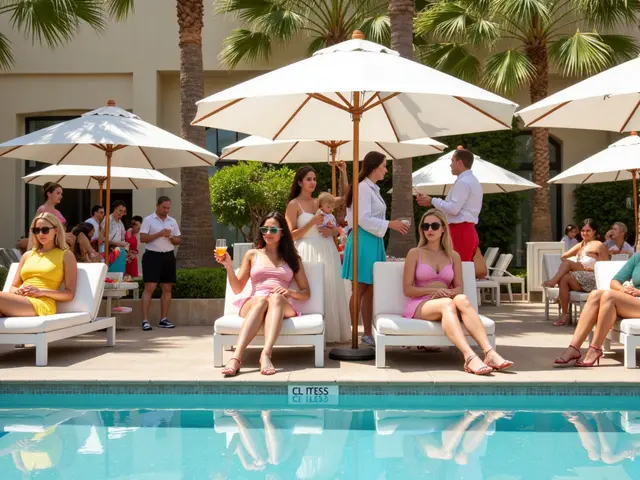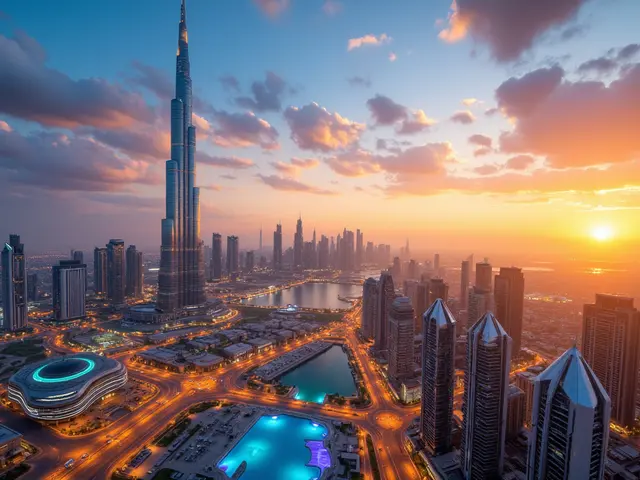Ask anyone living in or visiting Dubai what defines the city’s unique blend of ambition and extravagance, and you’ll hear one name pop up every single time: Burj Al Arab. Perched dramatically on its own island just off Jumeirah Beach, this sail-shaped giant has redefined what luxury means, not just in Dubai, but all over the world. Forget what you think you know about five-star hotels—Burj Al Arab laughs at your five stars and hands itself a ‘seven-star’ status, a cheeky title even if it isn't officially recognized. Still, what’s fact is that this hotel is where Dubai’s love for the spectacular comes to life and where the word ‘ultimate’ isn’t just an adjective—it’s a promise.
Dubai’s Shining Jewel: The Legacy and Architecture of Burj Al Arab
It’s not just a hotel, it’s a symbol. Right from the moment the idea was pitched in the 1990s, Burj Al Arab was meant to be an icon for Dubai—a city that was (and still is) reinventing itself at light speed. Yes, Burj Khalifa might be taller, but the Burj Al Arab’s silhouette is recognizable from airplanes, yachts, and just about everywhere in the city. British architect Tom Wright of WS Atkins designed the hotel to mimic the billowing sail of a dhow, those boats you still see gliding along Dubai Creek during the city’s busier evenings. They built the thing 280 meters out at sea, using reclaimed land, with a private bridge connecting it to Jumeirah Beach Road. And it soars 321 meters high, making it taller than the Eiffel Tower. Construction wasn’t just about building up; it was about building out. Engineers had to create a man-made island and anchor it with 230 massive concrete piles into the sea bed, some as deep as 40 meters. The result? A structure as solid as it is stunning—and proof that when someone in Dubai says, ‘Let’s do the impossible’, you might want to take them seriously. Step inside and it’s pure drama: a 180-meter tall atrium with a kaleidoscopic palette of colors, never-ending gold leaf (there’s literally 1,790 square meters of it all over the hotel), dancing fountains, and a sense that you’ve just left reality at the door. There’s even a helipad toward the top—we’ve seen everything from tennis matches (remember Federer vs. Agassi in 2005?) to supercars and even a ‘sky-high’ wedding hosted there in 2021. Locals and expats alike instantly recognize the gleaming white ribs of the ‘sail’ structure as a proud statement: this is Dubai, unapologetically pushing the envelope every single day.
The Art of Indulgence: Inside Burj Al Arab’s Guest Experience
What happens on the other side of those rotating doors? Let’s just say—Burj Al Arab is where wish lists become to-do lists. The hotel only offers suites; 202 of them, spanning two stories each, and screaming opulence at every turn. Think: rotating beds in the Royal Suite (yes, you read that right), private cinemas, Hermes amenities (they have entire trays in the bathrooms), and even 24-karat gold iPads for your in-room concierge needs. Want to be picked up from the airport? Request a Rolls-Royce Phantom, complete with a licensed driver who knows the city’s traffic better than Waze. Or, if you’re coming in by yacht, the hotel can arrange a berth just for you. Locals sometimes assume Burj Al Arab is for international jet-setters. Truth is, many Emiratis and Dubai-based residents love a weekend splurge here, especially for anniversaries, Eid breaks, or surprise staycations that mean never having to leave the city. The staff-to-suite ratio is nothing short of extraordinary—reportedly 8:1. That means a team is waiting to make your coffee just the way you like it before you even realize you wanted one. If you’re marking a special occasion, let them know. They’re pros at orchestrating in-suite proposals, private dinners on the helipad, and personalized spa journeys inside the Talise Spa. Dubai’s tradition of hospitality—a prime value since the Bedouin days—is alive and flourishing in every corner of the Burj.
- Hermes-branded toiletries (custom for men and women)
- Extensive pillow menu (for all types of sleepers)
- Private butler service 24/7
- Access to exclusive private beach
- Luxury chauffeur or helicopter transfers
And if you’re celebrating Ramadan or Eid, the hotel offers extravagant Iftar and Suhoor menus, blending traditional Emirati flavors with international flair, custom-arranged for every guest. During these periods, the hotel’s décor fuses Islamic patterns and contemporary aesthetics—think Arabic calligraphy gracing your suite door, and Ramadan tents on the private terrace.
Dining at Altitude: Restaurants That Redefine Gourmet in Dubai
Dubai is known for next-level dining, and Burj Al Arab takes it a notch—or five—higher. The towering Al Muntaha sits 200 meters up in the air with floor-to-ceiling windows dropping into the blue Gulf. Chef Saverio Sbaragli turns local seafood and French classics into edible sculptures, making this a must-do for business lunches or that once-in-a-lifetime date night. The dress code is smart, and reservations can vanish months in advance, especially during winter. A local tip? Book for sunset—on a clear day you’ll watch the sky turn pink over Palm Jumeirah. On the flip side, step underwater at Al Mahara, Burj Al Arab’s iconic ‘aquarium’ restaurant. The theme? Seascapes—whether you want to dine beside live coral and swirling fish, or just feel like you’re inside a James Bond film. Emirati favorites like hammour fillet are reimagined with French twists, and there’s always locally sourced caviar if you’re feeling glam. For casual afternoons, Sahn Eddar serves high tea in the atrium—a crowd favorite with UAE nationals and tourists alike. Want something bespoke? Ask for a chef’s table or join an afternoon tea with private harpist serenade. Foodies in Dubai also drool over the degustation events Burj Al Arab hosts with Michelin-star guest chefs, usually announced during Dubai Food Festival each February and March. And yes, the kitchen can accommodate every dietary restriction: halal, kosher, gluten-free, or vegan menus are part of the everyday luxury.
Exclusive Experiences: What Sets Burj Al Arab Apart in Dubai
There’s no such thing as ‘ordinary’ here, whether you’re on a family holiday, closing a big business deal, or just looking to treat yourself. Take the Journey to Luxury, Burj Al Arab’s private tour that peeks behind the curtain—think secret staircases, original design sketches, and even a few stories you’ll only hear inside these walls. Locals often gift this VIP tour to visiting friends or clients; it’s the kind of memory that starts dinner table conversations for years. The Talise Spa on the 18th floor (with separate men’s and women’s areas, in line with local customs) offers rituals that merge Arabic ingredients—like rosewater, oud, and desert minerals—with global wellness trends. Fun fact: the infinity pools here have sweeping sea views, and there’s a private cabana culture that draws in the city’s elite most weekends. Memberships do exist, but they’re as exclusive as it gets and waitlists are not unheard of. On the water side, Burj Al Arab’s private beach is a sand-and-sea playground. Think jet-skiing with city skyline views or sipping mocktails at sunset, toes buried in powdery white sand. If it’s too hot (and in Dubai, that’s a given from June to September), request private tented cabanas with cooled interiors and butler service, keeping with Dubai’s blend of tradition and innovation. For special dates—think Emirati National Day, New Year’s Eve, or Dubai Shopping Festival—Burj Al Arab’s team pulls out all the stops. There are private fireworks shows, VIP gala dinners, and themed parties where even residents find something new. And don’t forget the nearby Wild Wadi Waterpark: suite guests can use unlimited access passes, making it a hit with families or after-hours thrill-seekers who want adrenaline before dinner.
Who Should Stay—And How to Make the Most of Your Visit
If you’re reading this and thinking, ‘Sounds great, but is it for me?’, remember that Burj Al Arab isn’t just a hotel; it’s a Dubai rite of passage, regardless of whether you’re a resident, business traveler, or someone who just wants to sample the city’s extravagant edge. Locals often book a night or two for honeymoons, anniversary splurges, or Eid breaks—all about savoring the best while skipping the airport queues. Yes, there’s prestige, but the mood is friendlier than you’d think. Most staff are multilingual, and there’s a chilled vibe beneath the gold. If you’re an expat, this place makes an epic backdrop for visiting family—imagine greeting your parents on a marble staircase, or treating your partner to a spa day that shames anything you’ve tried in Paris or London. The hotel’s concierge team knows the city inside-out: they’re the gatekeepers to Dubai’s dining scene, designer boutiques in Jumeirah and City Walk, and can even snag invites to launch events during Dubai International Film Festival or Art Dubai. Tourists chasing Instagram fame won’t find better angles: from breakfast trays floating in a private pool to rooftop shots with the entire cityscape outlined behind crystal glass. And for the business crowd, private meeting suites, executive lounges, and high-security protocols make this a favorite for royal families, global CEOs, and anyone needing confidentiality with their caviar. Craving solid numbers? Here’s a glimpse:
| Fact | Figure |
|---|---|
| Height | 321 meters |
| Number of Suites | 202 |
| Staff-to-suite Ratio | 8:1 |
| Gold Leaf | 1,790 sq. meters |
| Private Beaches | 1 exclusive stretch |
Quick tip for booking: Dubai’s winter (November–March) is peak season, with hotel rates soaring and rooms booked out weeks in advance. Locals sometimes score better rates right before Ramadan or during the city’s slower summer months (June–August), where heat means you’ll appreciate the spa, cool pools, and AC even more. Bottom line—Burj Al Arab is not just another pretty building. It’s Dubai’s message to the world: here, luxury is a lifestyle, tradition is timeless, and pushing the limits is just another day at the office. If you want to feel Dubai’s spirit distilled into one experience, the Burj Al Arab is where your story starts.




